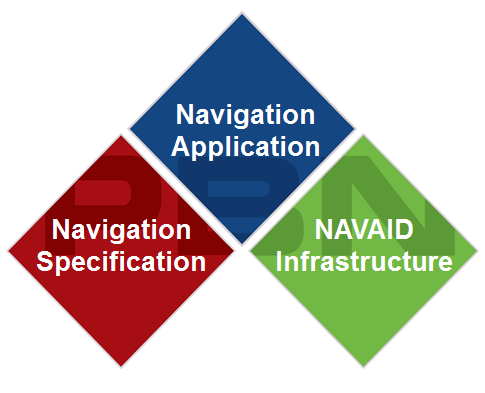As previously stated, the key enabler for PBN is area navigation.
Performance-based Navigation (PBN) is the 'marriage' of a Navigation Infrastructure and a set of aircraft capabilities as detailed in a Navigation Specification. These two support a Navigation Application that is utilised within the airspace. The required navigation application is defined by an airspace concept that identifies the level of performance that is needed from the aircraft operating within that airspace.

PBN does not utilise all ground-based 'conventional' NAVAIDs. The NDB is too inaccurate for PBN and is not considered for any navigation specification. Furthermore, the performance of VOR limits its use to just one Nav Spec and that is RNAV 5. VOR performance is not robust enough to support a 1 or 2 NM navigation performance and is therefore not considered for the more demanding Nav Specs.
DME/DME will enable a position estimation good enough to support a 1NM performance; however, DME/DME will not be able to support operations which demand less than 0.5NM performance.



Space-based infrastructure today only focuses on the US NAVSTAR Global Position System (GPS) and appropriate augmentations to make the satellite signal acceptable for civil aviation use. These augmentations are Aircraft Based Augementation Systems (ABAS), which includes as one option Receiver Autonomous Integrity Monitoring (RAIM), and Satellite Based Augmentation Systems (SBAS), which in Europe is provided over the European Geostationary Navigation Overlay Service (EGNOS). Ground Based Augmentation Systems are precision approach systems and are not considered as an augmentation system for PBN.
The Russian GLONASS, although operational, is not currently considered within the PBN Manual. Similarly, the emerging European Galileo system and Chinese Beidou system are not, as yet, recognised within PBN.
For more information on the Navigation Infrastructure, click below
The Navigation Specification details the specific requirements for the aircraft's avionics and the flight crew's management of the aircraft to meet a navigational performance.
Within Volume II of the PBN manual there is a detailed description of what the aircraft must be capable of to meet a lateral (and in the final phase of flight - vertical) performance in terms of accuracy with stipulated integrity and continuity requirements. Furthermore, the Nav Spec will detail the functionalities the aircraft and navigation computer must be able to execute together with a list of the appropriate sensors to enable a position estimation which is good enough to meet the specified performance. Finally, the Nav Spec details what the pilot is required to do with the aircraft's avionics to ensure the specified performance is met.
There are two types of specifications: RNAV and RNP. The nominal difference between the two specifications is that a RNP specification requires the aircraft to have ‘On-board Performance Monitoring and Alerting’ (OBPMA) whilst a RNAV specification does not. In reality, the primary difference between RNAV and RNP aircraft is their year of manufacture. Older aircraft, built prior to 2000, have less functionality and are considered to be RNAV while more modern aircraft with greater levels of functionality are considered to be RNP.

Aircraft will be certified to one or more navigation specification by the regulatory authorities and the Aircraft's Flight Manual (AFM) will detail the navigation specifications that have been approved. The flight crew must also be suitably trained and approved. Within Europe today this is primarily managed through standard Instrument Rating training and the pilots will hold 'PBN privileges'. There are two exceptions to flight crew approvals and these are RNP 0.3 for rotorcraft operations and the very demanding RNP Authorisation Required Approach RNP (AR) APCH which require special approval.
For more information on the Navigation Specifications, click below

The Navigation Application is the 'marriage' of an appropriate navigation infrastructure and a specific navigation specification.
The Nav Infrastructure and the corresponding Nav Spec support the Navigation Application to be used within the airspace. The required navigation application is defined by an airspace concept which identifies the level of performance that is needed from the aircraft operating within that airspace.
The desired Navigation Application will be based on more than just the capable navigation performance. The State or region's communication, navigation and surveillance (CNS) capabilities together with ATM procedures and tools and aircraft capabilities will define what Navigation Application can be applied within the airspace.
Therefore, PBN plays a role in support of operations in the target airspace but it isn't the only factor. The State or region will evolve an airspace concept where PBN is just one element in the technological requirements to support the planned operation. The required Navigation Application forms only one part of that overall airspace concept.